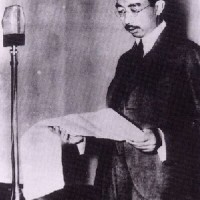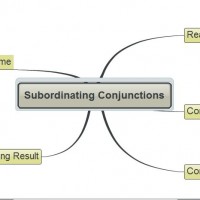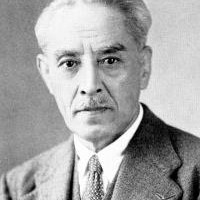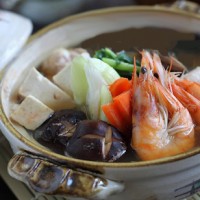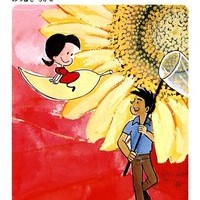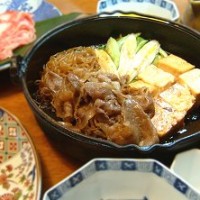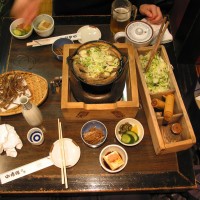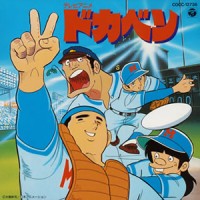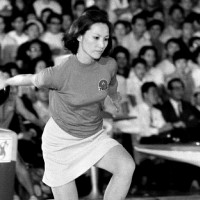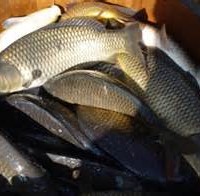Monthly Archives: December 2015
Tuesday: Japanese Proverb
12/30/2015 blog
Naranu Kannin Suru-ga Kannin (True patience lies in bearing [It is true bearing to bear] what is unbearable.] (Emperor Showa Announcing The Defeat of Japan in 1945) Patience is one of Japan’s many great virtues. Traditionally, Japanese leaders, including statesmen, owners of the companies, and teachers, are considered to be patient. All Japanese thought that they became successful just because they possessed tremendous amount of patience. In other words, no Japanese was chosen to be a leader if he blew up easily in public. Emperor Showa is one of the most patient person in the world – He himself announced the end of the WWII (https://en.wikipedia.org/wiki/Gyokuon-h%C5%8Ds%C5%8D), which meant Japan surrendered. …
Monday: One Point Japanese Clinic
12/29/2015 blog
How To Use Conjunctions (2) (https://en.wikipedia.org/wiki/Conjunction_(grammar)#Subordinating_conjunctions) Now you can tell the difference between ‘Coordinating Conjunctions’ and ‘Subordinating Conjunctions.’ Your next step is ‘practice’ to use them, right? Let’s get started! [Toki] Let’s talk about “toki” now. It is almost always translated into “when” in English. There are some grammatical patterns when you use “toki” in Japanese. I. Noun + no toki (ni) (wa) Gakusei-no toki-ni furansugo-wo benkyo shimashita. (= When I was a student, I studied French.) II. I-adjective + toki Atama-ga itai toki-wa kono kusuri-wo nonde kudasai. (= When you have a headache, please take this medicine.) III. Na-adjective + toki …
Friday: Japanese Hero
12/26/2015 blog
Mifune Kyuzo/God of Judo (https://en.wikipedia.org/wiki/Kyuzo_Mifune) (Mufune Kyuzo 1883 – 1965) It is in 1882 that Kano Jigoro (https://en.wikipedia.org/wiki/Kan%C5%8D_Jigor%C5%8D) established Kodokan (https://en.wikipedia.org/wiki/Kodokan) in Tokyo, Japan, after mastering Jujutsu (https://en.wikipedia.org/wiki/Jujutsu). Kano developed his own philosophy and skills in Jujutsu into Judo. Generated from Jujutsu, Judo has been independent of Jujutsu since Kano established Kodokan. In one word, Judo is to Jujutsu as Cro-Magnon man is to Australopithecus. (The Theory of Evolution) (Jujutsu = Australopithecus) (Cro-Magnon Men = Judo) Mifune is called “God of Judo’ while Kano, the founder of Judo, ‘Father of Judo’ or ‘Father of Japanese Physical Education.’ Their nicknames express their functions in Japanese society very well. After joining Kodokan, Mifune became an ‘ambassador’ of Kano’s philosophy …
Thursday: Japanese Food
12/25/2015 blog
Yose Nabe (https://en.wikipedia.org/wiki/Nabemono) (Yosenabe) Yosenabe is one of those ‘Nabemono’ cuisines in Japan and especially popular in winter. ‘Yose’ comes from ‘Yoseru (= Collect)’ – that is, you put anything you want in the pot (= ‘Nabe’). That is why ingredients for Yosenabe really vary – seafood, vegetables, meat, mushrooms, and tofu-related products. The soup is made with shredded bonitos, seaweed, and so on, which is seasoned with miso (= bean paste), soy sauce, sake (= rice wine), and salt. Take a look at these varieties of Yosenabe! All family sit down around the dining table and enjoy ‘Nabe’ while it is being cooked. When popular ingredients are running out, housewives …
Wednesday: Japanese Manga
12/23/2015 blog
Chiisana Koi-no Monogatari (Original Manga Version) (Mitsuhashi Chikako, Author) It was in 1962 that Mitsuhashi Chikako (1941-) started to write “Chiisana Koi-no Monogatari (A Little Love Story)” in the magazine called “Utsukushii Judai (The Beautiful Teens).” It was not until so many comics version (Look at 103 in this list: https://en.wikipedia.org/wiki/List_of_manga_series_by_volume_count) were published that I finally recognized how popular this simple manga was in those days – early 70’s, when I was early teens. Manga itself is NOT my favorite at all. Collections of simple comic strips (4 scenes). A mediocre plot of love stories between high school aged boy and girl. The girl (heroine) is the one you see on …
Tuesday: Japanese Proverb
12/23/2015 blog
Tokoro Kawareba Shina Kawaru (Each country has its own customs./So many countries, so many customs.) (Sukiyaki Kansai-Style) (Sukiyaki Kanto-Style) Customs are different from one another, depending on the locations. Look at those pictures above! I have introduced Sukiyaki to you before in this blog. Ingredients are different and how to cook/season/serve the dish is different between Kansai and Kanto. I am from Kansai area, so I am used to the picture on top. <“Illustration Phragmites australis0”. Licensed under パブリック・ドメイン via ウィキメディア・コモンズ – https://commons.wikimedia.org/wiki/File:Illustration_Phragmites_australis0.jpg#/media/File:Illustration_Phragmites_australis0.jpg> The plant in the picture above is called “Ashi,” “Yoshi,” or “Kita Yoshi” in Osaka area (https://en.wikipedia.org/wiki/Namba) while the same kind of plant is called “Hama Hagi” in …
Monday: One Point Japanese Clinic
12/22/2015 blog
How To Use Conjunctions (1) (Conjunctions = ‘Joining’ Words) Simple sentences are really simple and easy to make. In one sentence, there is only one subject and one verb. That’s all you have to pay attention to. When you get to the intermediate level in Japanese, however, you start to make compound sentences. In contrast to simple sentences, you will find more than one subjects and verbs. You have to coordinate them accordingly. That’s where you start to get confused. To connect two clauses consisting of subjects and verbs, you need conjunctions. Conjunctions are ‘joining’ words. There are two categories in conjunctions – coordinating conjunctions and subordinating conjunctions. Coordinating conjunctions are easy …
Friday: Japanese Hero
12/21/2015 blog
Nogi Maresuke (https://en.wikipedia.org/wiki/Nogi_Maresuke) (The Scene of Nogi’s Suicide through Fidelity called “Junshi”) In Japanese history, there have been tremendous numbers of Junshi (https://en.wikipedia.org/wiki/Junshi). General Nogi did that along with his wife when the Emperor Meiji, who Nogi admired to his bone as his lord, passed away. There were several occasions when it would have happened before that. However, Nogi finally did that admirably with his spouse, because of which Nogi Maresuke is enshrined as a god in Nogi Shrines (Note: There are several Nogi Shrines in Japan, which were established by the people who were sincerely impressed by Nogi’s Junshi.) all over Japan. Nogi is indubitably the Japanese hero. Nobody, if he knows …
Thursday: Japanese Food
12/20/2015 blog
Yanagawa Nabe/Dojo Nabe (https://en.wikipedia.org/wiki/Dojo_nabe) (Dojo Nabe/Yanagawa Nage Course) “Dojo Nabe” or “Yanagawa Nabe” is the “Nabemono” dish (https://en.wikipedia.org/wiki/Nabemono) whose main ingredient is dojo (https://en.wikipedia.org/wiki/Pond_loach). They say that “dojo” energizes you, which is why “Dojo Nabe” is eaten in winter! “Dojo Nabe” is categorized into three (3) kinds – 1) Marunabe, 2) Nuki Nabe, and 3) Yanagawa Nabe. Let’s take a look at each. 1) Marunabe: Put dojo into sake (https://en.wikipedia.org/wiki/Sake) in a pot. The fish have to be alive (How cruel!). Next you put the lid on the pot. At first, they frantically try to get out, but in vain. After a little while, they get drunk and tamed. You put them …
Wednesday: Japanese Manga
12/17/2015 blog
Dokaben (https://en.wikipedia.org/wiki/Dokaben) (https://youtu.be/LA1zLFL1VnM) “Doka” means “big” while “ben” means “lunch box.” So, “Dokaben” means “A Big Lunchbox.” Yamada Taro, who is the main character in this manga, eats that much – “Dokaben.” He, however, plays baseball as a genius. When he was a middle school student, Taro played Judo. But he decided to switch to baseball. Written by Mizushima Shinji, Dokaben is a well balanced sports manga, which was started in “Weekly Shonen (Boys) Champion.” This series of “Dokaben (https://en.wikipedia.org/wiki/Dokaben)” was a huge hit and published from 1972 to 1981. On the other hand, its TV series started in 1976 and lasted until 1979 (163 episodes)!? What made this manga so …
Tuesday: Japanese Proverb
12/16/2015 blog
Saru-mo Ki-kara Ochiru/Kobo-mo Fude-no Ayamari (Saru-mo Ki-kara Ochiru <= Homer sometimes nods>!?) When you look up those proverbs in the dictionary, you will always find the translation – “Homer sometimes nods.” Yes, this means “A good marksman may miss.” Nobody can avoid making mistakes from time to time. Even Ironman, a Marvel Hero, made lots of mistakes, didn’t he? So, its translation is done. Are you happy? If so, this column ends here… Wait a second! That is NOT what I meant to say. You came all the way – how far? – to my website. So, I need to tell you something special so you will feel it was …
Monday: One Point Japanese Clinic
12/10/2015 blog
Zenzen Daijobu?! (Typhoon) A: “Konomae-no Taifu Daijobu deshitaka.” (= Did you survive the typhoon the other day?) B: “Zenzen Daijobu deshitayo!” (= We were totally fine.) A: “Yoko-san-no Repoto-wa Dodeshitaka.” (= How did you like Yoko’s report?”) B: “Zenzen Yokatta desuyo.” (= It was very good.) (Nothing else would make you happy?!) Let’s take a close look at those two – “Zenzen Daijobu” and “Zenzen Yokatta.” The golden rule about an adverb – “Zenzen” – is that “Zenzen” has to be used with negative words like “-nai.” <Example> “Tsukaremashitaka.” (= Are you tired?) “Iie, zenzen tsukareteimasen.” (= No, not at all.) …
Friday: Japanese Hero
12/07/2015 blog
Nakayama Ritsuko (https://en.wikipedia.org/wiki/Ritsuko_Nakayama) (Ritsuko in Competition) Do you believe in a miracle? I do! Why? When I was a 6th grader (1973), I went to a bowing alley one day. In one of the games I played, I scored “276.” That’s why! “276” out of the perfect “300” is an insane score in those days? In most frames I got strikes. Some others I got spares. In tenth frame, I got 2 strikes and…spared (As you may knowit, it doesn’t matter at all whether you get a spare or not in the tenth frame. It does matter how many you get in the first throw.)! Was I possessed by a …
Thursday: Japanese Food
12/07/2015 blog
Koikoku (Kois Before Being Cooked) Speaking of “Koi,” Americans who know what they are tend to think of them as the living art, which you can see in the wealthy’s pond or in the public Japanese garden like these: (Well, $10,000 x 9 = $90,000 plus how many more?) (Look for the Koi food vending machine to feed them!) Today’s topic, Koikoku, is the cooked Koi in the pot with miso (= bean paste). This type of Koi are NOT colorful or artistic looking like those above, but plain and ready-to-eat looking like the one on the top. First, they are chopped up and put into the pot like this: …
Wednesday: Japanese Manga
12/07/2015 blog
Mahotsukai Sarii/Sally the Witch (https://en.wikipedia.org/wiki/Sally_the_Witch) (https://youtu.be/0F0xAFaJApk) (Record Jacket) According to Yokoyama Mitsuteru (https://en.wikipedia.org/wiki/Mitsuteru_Yokoyama), who drew this very poplular manga in 1966, the American sitcom, Bewitched (https://en.wikipedia.org/wiki/Bewitched), inspired him to create this manga. (Japanese Version Opening Naration: https://youtu.be/WUoYMSpKdMg) “Bewitched (= Okusama-wa Majo)” became so popular in late ’60s and early ’70 in Japan, as well as in US. The settings in both TV shows were different from each other, “Sally the Witch (= Mahotsukai Sarii)” in anime enjoyed its popularity whether it was in black and white or in color. In “Bewitched,” the main character, a housewife (Samantha), was so cute and attractive while Sarii (= Sally) in “Mahotsukai Sarii” was a 5th grader, who was again …

